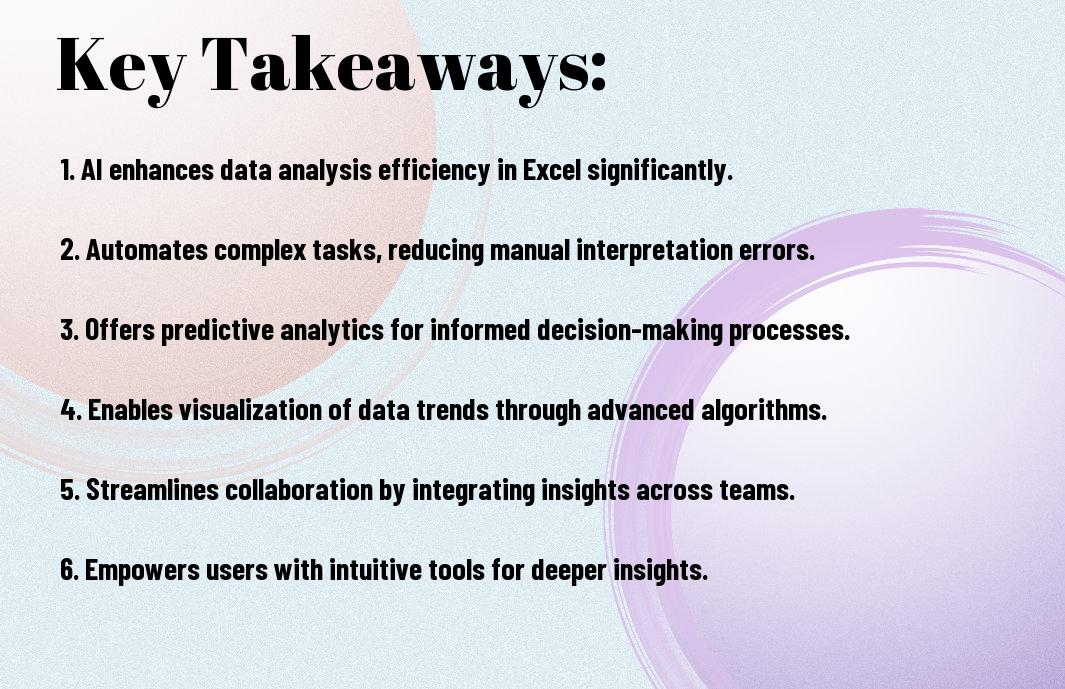Over the past few years, the integration of artificial intelligence into Excel has transformed the way you analyze and interpret data. AI-driven Excel solutions enhance your ability to uncover insights, automate tedious tasks, and improve decision-making processes, allowing you to focus on strategic initiatives. This blog post will examine into the various ways AI technology can fundamentally alter your approach to data interpretation, empowering you to harness its full potential in your work.
Understanding AI-Driven Excel Solutions
The integration of AI-driven solutions in Excel is transforming how you analyze and interpret data. These sophisticated tools leverage machine learning algorithms and automation to enhance your analytical capabilities, enabling more efficient data manipulation and insightful forecasting. With AI’s ability to learn patterns, you can uncover complex insights that were previously hidden, making data interpretation more profound and impactful.
Definition and Overview
Excel is a powerful spreadsheet application that has evolved to incorporate AI-driven functionalities. These solutions provide you with tools that can automate data analysis, streamline workflows, and empower you to make data-driven decisions with enhanced accuracy and speed.
Key Technologies Involved
Behind the scenes, AI-driven Excel solutions utilize various technologies, such as machine learning, natural language processing, and data visualization tools. These technologies create a dynamic environment where you can efficiently process large volumes of data and extract meaningful insights.
Another vital aspect of these technologies includes algorithms that automate tedious tasks, allowing you to focus on interpreting the results rather than the processes. Integrating models that predict trends also empowers you to make informed decisions based on real-time data analysis. Additionally, natural language processing facilitates user-friendly interactions, enabling you to ask questions about your data in plain language and receive actionable insights quickly.

The Current Paradigms of Data Interpretation
You might find that traditional methods of data interpretation have long relied on manual analysis, statistical techniques, and straightforward visualization. Analysts often engage in extensive data cleaning, entry, and formula application, which can be time-consuming and prone to human error. While these methods have effectively served various fields, the complexity and volume of modern data require a rethink of how analysis is approached to derive meaningful insights.
Traditional Methods
Against the backdrop of the evolving data landscape, traditional methods often lean heavily on manual inputs and rule-based analysis. This can lead to slow turnaround times and inefficiency, as data analysts sift through mountains of information. Relying on these conventional techniques may restrict your ability to quickly respond to emerging trends and patterns in your data.
Limitations of Existing Approaches
Between the inherent inefficiencies and the risk of human error in data processing, existing approaches fail to meet the demands of real-time data interpretation. Often, these methods lack the scalability to handle increasing data volumes, leaving you with outdated insights that could hinder decision-making. Moreover, traditional techniques frequently ignore the nuances of complex datasets, missing opportunities for actionable intelligence.
Current analysis methods may not adequately leverage advanced technologies required to unlock the full potential of your data. You may find that conventional statistical techniques overlook correlations and insights hidden within large datasets. Additionally, the reliance on structured data formats can limit the depth of analysis, often leading to one-dimensional insights that overlook the complexity of insights that AI solutions can provide. As business environments evolve, recognizing these limitations presents an opportunity to transition towards more innovative, AI-driven approaches to data interpretation.
Your Insights on How AI is Changing Data Interpretation
Your understanding of data interpretation is evolving with advancements in AI. These technologies enable quicker analysis and more nuanced insights, effectively transforming how you interact with data. By exploring tools like Empowering Excel with AI: A Comprehensive Guide to …, you can simplify complex data tasks and enhance decision-making processes.
Enhanced Data Analysis Techniques
Across various sectors, AI-driven methods are introducing innovative analytical techniques that provide deeper insights. By employing advanced algorithms, you can identify patterns and trends that traditional methods might overlook, allowing for more informed strategies and better outcomes.
Real-Time Data Insights
Across the landscape of data interpretation, real-time insights powered by AI enhance your ability to make decisions promptly. AI technologies analyze incoming data as it is generated, enabling you to respond swiftly to changes and trends without delays.
For instance, AI can monitor sales data as it streams in, highlighting fluctuations that signal shifts in customer behavior. This immediate feedback allows you to adjust marketing strategies in real-time, improving your responsiveness and overall effectiveness in meeting business objectives.

Case Studies: Successful Implementations
To illustrate the transformative potential of AI-driven Excel solutions, various case studies reveal significant advancements in data interpretation across industries:
- Company A increased their data processing speed by 70% by integrating AI algorithms, reducing analysis time from days to hours.
- Company B reports a 40% improvement in forecasting accuracy using AI-enhanced predictive models to interpret sales data.
- Company C automated reporting processes that saved them 200 hours annually, allowing staff to focus on strategic tasks.
- Company D improved customer insights by 30%, leveraging AI tools for sentiment analysis on feedback data.
Business Applications
On the business front, organizations like yours can leverage AI-driven Excel solutions to streamline operations and enhance decision-making capabilities. These tools allow for real-time analysis, facilitating quicker responses to market changes while optimizing resource allocation and improving forecasting methodologies.
Academic and Research Uses
Along with business applications, the academic field also benefits from AI-driven Excel capabilities, enhancing research methodologies and data analysis techniques. By implementing these solutions, you can improve the accuracy of your findings and automate tedious statistical calculations.
Research institutions are increasingly adopting AI technologies to analyze vast data sets, allowing for deeper insights and more rigorous studies. You might find that AI-driven algorithms can parse through complex variables more efficiently, enabling you to focus on hypothesis development and interpretation of results. This elevation of data analysis not only supports stronger conclusions but also enhances collaboration and sharing of findings across your academic network.
Challenges and Considerations
Unlike traditional data analysis methods, AI-driven Excel solutions present unique challenges. You may encounter issues related to data quality, integration, and user adoption. With these advanced tools, understanding the output requires a strong grasp of both the technology and the underlying data, making it crucial to invest time in training and support to unlock their full potential.
Ethical Implications
Around the integration of AI in data interpretation, you need to consider ethical responsibilities. Your reliance on machine-driven insights may raise questions about data ownership, bias, and transparency. As you implement these technologies, be aware of the implications for privacy and ensure that your approach aligns with ethical standards.
Technical Limitations
Across many AI-driven solutions, limitations can arise that impact their effectiveness and reliability. You might find that the algorithms used lack adaptability to unique datasets, leading to misinterpretations. Furthermore, the quality of input data significantly affects the outcome, making it crucial for you to ensure that your data is accurate and comprehensive.
Consequently, while exploring AI-driven Excel solutions, you should be mindful that their potential is often contingent on the underlying technology. The algorithms may not always accommodate the complexities inherent in your specific datasets. Coupled with varying levels of machine learning maturity, this can result in errors or oversights that could compromise your analysis. Thus, being aware of these technical limitations is vital for making informed decisions when interpreting data.
Future Perspectives
All indications suggest that AI-driven solutions will not only enhance your ability to interpret data but also open new avenues for innovation in business and analytics. As these technologies continue to evolve, the integration of AI with traditional data analysis practices will redefine how you approach data comprehension and decision-making.
Trends in AI and Data Analysis
One of the most notable trends you will observe in AI and data analysis is the increasing use of machine learning algorithms that automatically identify patterns in your datasets. This allows you to leverage data insights with unprecedented accuracy and efficiency, enabling smarter business strategies.
Potential Innovations
Around the corner, you can expect exciting innovations that will further transform data interpretation. Developments like natural language processing and advanced visualization tools will empower you to interact with data in more intuitive ways, enhancing your decision-making processes.
At the forefront of these potential innovations, you will find tools that facilitate real-time data interpretation, allowing for on-the-fly adjustments and insights. Imagine being able to pose questions to your data using natural language and receiving immediate, comprehensible answers. Furthermore, the development of customizable dashboards powered by AI could tailor insights specifically for your needs, making complex data more digestible. These advancements will enable you to extract actionable insights with ease and efficiency, fundamentally transforming how you perceive and utilize data in your decision-making processes.
To wrap up
Hence, AI-driven Excel solutions stand to significantly transform the way you interpret data, enhancing your analytical capabilities and decision-making processes. By leveraging advanced algorithms and machine learning techniques, you can gain deeper insights and streamline complex data tasks with ease. As you embrace these innovative tools, you’ll find that your approach to data interpretation evolves, allowing you to uncover patterns and trends that may have previously gone unnoticed. This not only boosts your efficiency but equips you to make more informed, strategic choices in your professional endeavors.